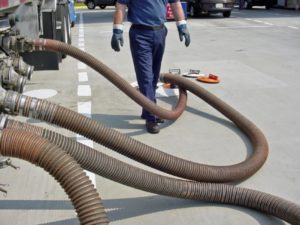 What do static electricity and hose assembly safety have in common? Most of us are familiar with the shock associated with static electricity. People have amused themselves for decades by shuffling their feet across a carpet and touching a doorknob for a quick zap. As entertaining as it might be, static electricity commands respect. In an industrial hose, static electricity can cause volatile products to explode or even burn through the side of a hose.
What do static electricity and hose assembly safety have in common? Most of us are familiar with the shock associated with static electricity. People have amused themselves for decades by shuffling their feet across a carpet and touching a doorknob for a quick zap. As entertaining as it might be, static electricity commands respect. In an industrial hose, static electricity can cause volatile products to explode or even burn through the side of a hose.
Static electricity is a serious concern when it comes to hose assemblies used in chemical transfer and some dry bulk materials. The products they transmit fall into two categories: accumulator or non-accumulator. The movement of accumulator liquids (hydrocarbon-based liquids such as gasoline) transfers electrons from the insulator (rubber hose) to the accumulator liquid. Continued movement of these products through an assembly not capable of transferring this charge makes it susceptible to explosion or heat damage. Workers handling these assemblies can be exposed to extreme electrical shock similar to picking up a live 115-volt line. In addition, ungrounded assemblies conveying accumulator liquids can act as storage batteries. Depending on the product, it can take several minutes for the charge to dissipate after movement has ceased. So, even after the pump has been turned off, workers are still vulnerable to a significant electrical shock if they touch the metal couplings.
Several industrial hose applications have the potential to carry a risk of electrical shock or damage to the hose through the buildup of static electricity. Many workers have been surprised at the powerful shock they received from touching the metal fittings on a steam hose that was not properly grounded. All assemblers and users must follow the hose manufacturer’s guidelines for proper static grounding. Typical static grounding procedures use the built-in static wire (when present) or helical wires. Assemblies that require grounding must be tested for electrical continuity. This is done by taking a multimeter reading and comparing it to those supplied by the hose manufacturer. Not only should these assemblies be hydrostatically tested on a regular basis for serviceability, but they should be periodically checked for electrical continuity because in rare occurrences, the static wire or helical wire may fracture during prolonged use and environmental factors.
To balance the positive and negative charges in an industrial hose, the hose must be grounded properly. Stay safe by testing these assemblies before installation and periodically thereafter.
Amazon Hose & Rubber offers testing and inspection services to help keep you and your employees safe on the job. Please contact our experienced Sales Technicians at 407-843-8190 or visit our website at www.amazonhose.com.